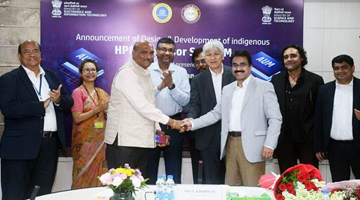Customs Classification of Textiles and Textile
Articles under HSN-Explanatory Notes
Authored by : Ajay Kumar Gupta, IRS
Published by : Avante-Garde Publications, Chennai
Pages : 420
Price : Rs 2,500 ( USD 100)

THOUGH the exports of textiles from India may not reach the target of USD 7.5 billions this year, it is an undisputed fact that in the post-quota regime, the share of India in the global textile trade is expected to double by 2012. Given the fact that the classifications under the Customs Tariff of the goods exported/imported plays a vital role in determining the import duties and export benefits, correct classification of the goods is easier said than done. One has to have a fair understating of the Section Notes, Chapter notes, headings, sub heading, end use of the product and even the process undertaken in manufacturing. When it comes to classification of textiles and textile articles, it is all the more complex with various unfamiliar words like knitted, crocheted, impregnated, carded etc and mere reading the entries in the Customs tariff will not be sufficient to arrive at correct classification. Here is the book written by MR Ajay Kumar Gupta, to bridge the gap between the tariff and trade dealing exclusively with the classification of the textiles and textile articles.
Textiles and Textile articles are covered under Section XI of the HS coding system in 14 Chapters from 50 to 63. The book is divided into 16 units and starts with a detailed discussion of the interpretative rules, followed by the Section Notes (of Section XI) in the first two units. Thereafter, goods falling under each of the 14 Chapters from 50 to 63 have been thoroughly described in a lucid manner from units III to XVI. Various textile related processes and the corresponding products and their correct classification have been explained with the help of multi-coloured pictures and flow charts which can be easily understood by even by a layman.
The author explained the importance of knowing clear description and mentioning the same on the invoice for identifying the correct classification with the help of simple illustrations like � if the invoice mentions the product as 100% cotton fabric", then,
It does not state whether it is woven, knitted or crocheted. If it is woven, it will fall under Chapter 52. If it is specially woven such as cotton corduroy or towel fabric or net fabric, it will fall under Chapter 58. If it is knitted, it is Chapter 60.
If it is declared as 100% woven cotton fabric, even then the description is not adequate, as the woven fabrics of 100% cotton are classified in heading no 5208 and 5209. To choose between these two headings, gsm should also be known. If the gsm is not more than 200, it will be under heading 5208, otherwise, it will be under 5209.
Similarly how do you classify a Saree? Will it be classified as a piece of fabric? A wearing apparel or a Made-up? What is type of fabric used for making tennis balls? What is the difference between a woolen suiting and a worsted suiting? What is the difference between coating, impregnation and lamination? What is the difference between Tapestries and Embroidery?
The author has done a painstaking research on several such issues and explained them in an easily understandable language with wonderful pictures and diagrams with a textbook precision. However, in his eagerness to explain everything with the help of pictures, the author chose to include the pictures of even brassieres and panties which could have been left to the readers� imagination. Each of the Units from III to XVI starts with a detailed explanation on the corresponding chapter notes wherein the technical terms used in the Chapter notes have been explained with figures to facilitate the understating of the basic concepts. Thereafter, the products covered under each heading have been explained with complete details of the processes involved. Though the author has taken utmost care in proof reading, he describes the meaning of �mutatis mutandis� as [with the necessary changes. (Page 420) How that �W� went inside the bracket is a mystery.
The author is a Textile Graduate (B. Tech) having five years field experience in Textile Industry and with nearly 12 years work experience in Chennai Customs, there can not be a better person to deal with the subject from the twin perspectives of a taxman and a technocrat.
All the links for the relevant webpages have been provided for further reading and the index at the end takes one directly to the commodity he is dealing with for immediate reference. Unlike the conventional books, the entire book was printed on fine quality glossy paper which is an excellent choice for printing this kind of book which contains a good number of colour photographs. The book is a must read and must retain in the library of anyone dealing with textile classification.
















